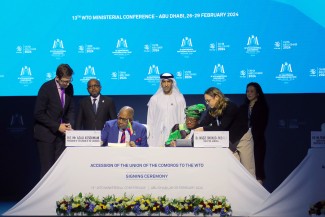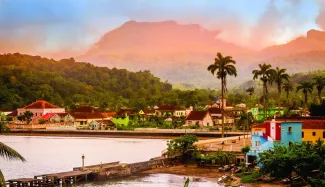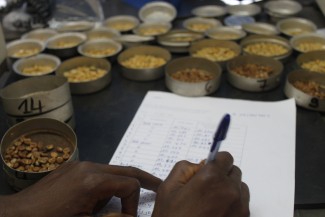Originally published by the World Bank on 1st October 2020
|
|
|
Since the COVID-19 pandemic brought tourism to a halt, queues to see the world’s most beautiful, natural wonders have disappeared. Gone are the clicking sounds of photos being snapped of wildlife through big lens cameras. On many island destinations like Hawaii and Fiji, beaches have been devoid of tourists due to pandemic-related travel restrictions.
This is beneficial for the recovery of the environment in the short term, but a catastrophe for national and local economies, communities, and the small and medium enterprises that depend upon nature-based tourism (NBT) for their survival. In fact, in the long term, if tourism does not recover, it will disincentivize communities from promoting natural resource management.
Across Africa, wildlife is the single biggest driver for NBT and much of the tourism takes place in protected areas. A study found that Africa’s 8,400 protected areas generated $48 billion in direct in-country expenditures. These revenues are a key source of financing protected area systems, and as they dry up—taking income, jobs and safety nets for local communities with them— threats to nature such as poaching and logging increase, degrading the very asset on which NBT is built.
For example, Maasai Mara Community Conservancies in Kenya used to receive $7.5 million per year in lease fees from tourism partners, which benefited 14,500 landowners and 116,000 community members. Without these payments, local landowners have fewer incentives to support conservation. Uganda Wildlife Authority generated 88% of its revenues from tourism and South African National Parks (SANParks) depended on tourism for 84% of their revenues. In Indonesia, the loss of tourism revenues of up to $6 billion has reduced support for parks and has impacted small businesses that rely on tourists.
Virunga National Park in the Democratic Republic of Congo closed to protect its endangered gorillas from the possible and unknown effects of COVID-19. This required cancelling 100% of their bookings and not taking new reservations, the financial effects of which have been devastating on cash flow for the park to protect the gorillas, provide support to rangers and the families of rangers who have been killed in the line of duty, and to help deliver essential disease prevention services.

As tourism recovers, a new publication from the World Bank’s Environment, Natural Resources and Blue Economy (ENB) Global Practice and the Global Environment Facility-funded Global Wildlife Program is available to offer some suggestions. Tools and Resources for Nature-Based Tourism curates the wealth of knowledge and resources available on NBT topics and makes them easily accessible to practitioners as they work to restart tourism.
For example, as governments rebuild their tourism sectors or shift to new markets and models, destinations, businesses, and communities may need information on marketing, planning, visitor forecasts, crisis management, and other considerations, as well as opportunities to learn new skills and form new partnerships. They can refer to resources in the report and guidebook under the themes:
- Destination Management
- Concessions and Partnership Models
- Nature-Based Enterprise Development
- Visitor Management
- Risk Management and Climate Change
- Training Resources
- Networks and Institutions
In compiling the report, hundreds of resources were identified through a stakeholder consultation with over 100 tourism experts, prior to the onset of the pandemic. An interactive platform also allows users to search for these resources by topics and keywords, and will be updated regularly with contributions from global practitioners as new tools are developed.
For example, the topic of concessions and partnerships models will become more important as countries look to diversify their revenue streams through tourism and beyond. The report identified 60 resources, such as “An Introduction to Tourism Concessioning: 14 Characteristics of Successful Programs” (IFC); “Guidelines for Tourism Partnerships and Concessions for Protected Areas” (Convention on Biological Diversity); and “Tourism Concessions in Protected Natural Areas: Guidelines for Managers” (UNDP). Webinars, case studies, and relevant networks and institutions are all available to provide guidance, and more will be added as they emerge.
“The sections in the report address many of the key issues confronted during the preparation and implementation of an NBT project. I can see myself going back to it again and again for information on particular issues at hand,” said Tijen Arin, a senior environmental economist with the World Bank who co-leads an NBT project in Nepal.

The World Bank has been investing in nature as an asset that creates jobs and supports economic development. In response to the growing demand from countries in recent years, the World Bank’s ENB Global Practice has developed an $800 million portfolio of 25 projects with NBT components. An additional seven projects with investments of more than $115 million are in the pipeline.
The NBT model that existed prior to the pandemic did not take into consideration the preservation of the environment nor did it equitably deliver benefits to local communities. In this dark cloud of the economic downturn, a silver lining is the chance to start with a clean slate and build the tourism sector back sustainably. Failure to do so, would only exacerbate the degradation of the natural assets that communities and tourism rely on and reduce economic and ecological benefits over the long term.
This one-stop platform can help provide the resources on recovery strategies and impacts that are needed to put conservation at the core of sustainable tourism.
* Dr. Claudia Sobrevila, Senior Environmental Specialist and Global Wildlife Program Manager at the World Bank, provided insightful guidance and helped conceptualize Tools and Resources for Nature-Based Tourism. She sadly passed away during its production, but strongly believed in “finding creative solutions to protect wildlife and building economic opportunities for local communities.
If you would like to reuse any material published here, please let us know by sending an email to EIF Communications: eifcommunications@wto.org.



